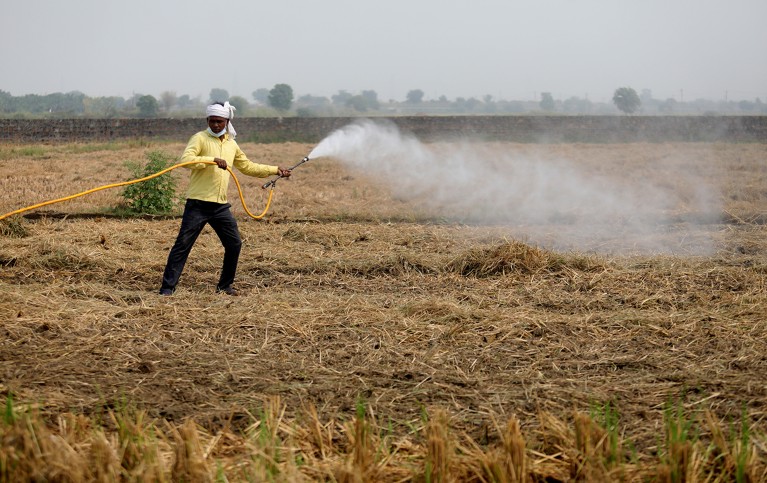- COMMENT
Microbes can capture carbon and degrade plastic — why aren’t we using them more?

A farmer in India sprays a harvested paddy field with a solution of fungi that breaks down plant stems, avoiding the need for stubble burning. Credit: Naveen Sharma/SOPA Images/LightRocket via Getty
Access options
Access Nature and 54 other Nature Portfolio journals
Get Nature+, our best-value online-access subscription
$32.99 / 30 days
cancel any time
Subscribe to this journal
Receive 51 print issues and online access
$199.00 per year
only $3.90 per issue
Rent or buy this article
Prices vary by article type
from$1.95
to$39.95
Prices may be subject to local taxes which are calculated during checkout
Nature 639, 864-866 (2025)
doi: https://doi.org/10.1038/d41586-025-00875-w
The views expressed in this article are the authors’ own, not those of the institutions, affiliations or agencies that fund their research.
References
Cavicchioli, R. et al. Nature Rev. Microbiol. 17, 569–586 (2019).
Rappuoli, R., Young, P., Ron, E., Pecetta, S. & Pizza, M. One Health Outlook 5, 5 (2023).
Crowther, T. W. et al. Cell 187, 5195–5216 (2024).
Peixoto, R. et al. Nature Rev. Microbiol. 23, 1–2 (2025).
Hodgson, A. et al. The U.S. Bioeconomy: Charting a Course for a Resilient and Competitive Future (Schmidt Futures, 2022).
Rappuoli, R. et al. Microbial Solutions for Climate Change: Toward an Economically Resilient Future (American Academy of Microbiology, 2025).
Mingolla, S. & Rosa, L. Nature Food https://doi.org/10.1038/s43016-025-01125-y (2025).
Wend, K., Zorrilla, L., Freimoser, F. M. & Gallet, A. Environ. Health 23, 49 (2024).
Danso, D., Chow, J. & Streit, W. R. Appl. Environ. Microbiol. 85, e01095-19 (2019).
Romanello, M. et al. Lancet 404, 1847–1896 (2024).
US Department of Energy. Clean Cities and Communities: Alternative Fuel Price Report (US Department of Energy, 2024).
Competing Interests
The authors declare no competing interests.

 Is the COP29 climate deal a historic breakthrough or letdown? Researchers react
Is the COP29 climate deal a historic breakthrough or letdown? Researchers react
 Drill, baby drill? Trump policies will hurt climate ― but US green transition is underway
Drill, baby drill? Trump policies will hurt climate ― but US green transition is underway
 Scientists’ warning to humanity: microorganisms and climate change
Scientists’ warning to humanity: microorganisms and climate change




